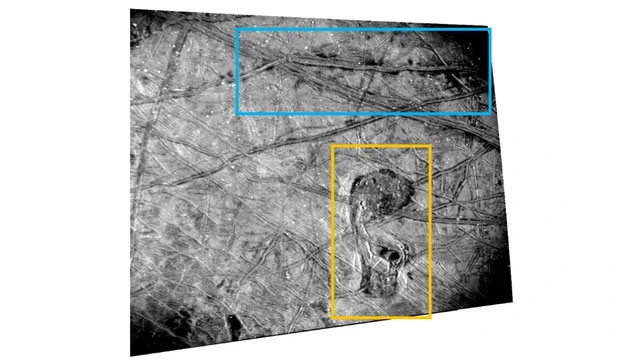NASA captured 'Platypus' moving in alien world
What NASA calls the "Platypus" isn't an animal, but it could be a hint at where alien life lurks .
According to Live Science, NASA has released new analysis related to a strange image of something appearing to be moving inside the icy shell of Europa , the alien world to which the agency is planning to send a probe. explorer arrives.
That "strange object" was named the Platypus, because viewed from above it looked exactly like the head of a platypus.

The "Platypus" structure is marked with a yellow rectangle, while the blue rectangle is a ridge that also has traces that suggest it could be where water from the underground ocean leaked out - (Photo: NASA ).
Europa is one of the large faces of Jupiter that NASA believes may harbor life.
Slightly smaller than Earth's moon, Europa is more like a planet. It has a magnetic field, an atmosphere containing thin oxygen, and a core of liquid iron. It is also thought to have an 18km thick icy crust that hides a salty ocean underneath.
Would that salty ocean bubble through the ice? The answer may lie in the interesting image of the "Platypus".
"Platypus" is the nickname for an area approximately 37x67 km in size , containing chaotic terrain consisting of mounds, ridges, ice blocks and dark reddish-brown material.
This is the youngest feature in the area photographed. New NASA analysis suggests that is most likely where Europa's icy shell allows pockets of salt water from the Moon's underground ocean to flow into the surface lake.
About 50km above the Platypus is a double ridge running east-west with strange stain-like markings around it, possibly residue from saltwater streams rising to the surface from Europa's ocean.
Therefore, although the Platypus is not a flesh-and-blood platypus, along with the double ridge above, it is a testament to the hypothesis of an underground ocean in Europa that NASA strongly believes.
The movement of this structure also suggests that this Moon is not a dead world, but on the contrary always operates like the earth, which gives it the ability to nurture life.
In addition, this could be an area that helps life-hunting ships access water carrying material seeping up from the underground ocean, which could provide evidence of potential organisms below.
The above images were recorded by the Jupiter Juno probe. But NASA has its own plan to take careful care of Europa with the Europa Clipper mission, scheduled to launch later this year.
- The unexpected truth about platypus
- Discover the largest platypus fossil in Australia
- Discovered a new species of platypus
- NASA has acknowledged the existence of aliens
- Video: Illuminate suspected alien spacecraft near the ISS station
- Latest weapons against antibiotic resistance - Platypus milk
- New type of diving
- When did platypus appear?
- Anonymous claims NASA is about to make an important announcement about alien life
- The platypus gene reveals the evolutionary secret of mammals
- NASA releases first image from the world's most powerful telescope
- NASA robot enters the alien 'river of life'
 Van Allen's belt and evidence that the Apollo 11 mission to the Moon was myth
Van Allen's belt and evidence that the Apollo 11 mission to the Moon was myth The levels of civilization in the universe (Kardashev scale)
The levels of civilization in the universe (Kardashev scale) Today Mars, the sun and the Earth are aligned
Today Mars, the sun and the Earth are aligned The Amazon owner announced a secret plan to build a space base for thousands of people
The Amazon owner announced a secret plan to build a space base for thousands of people